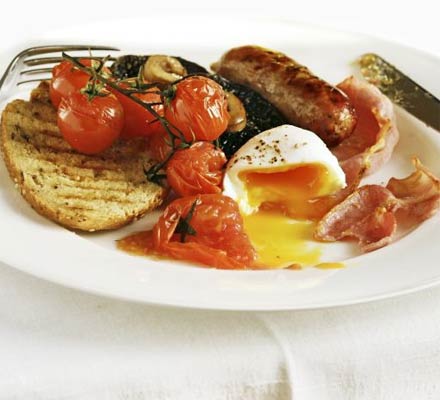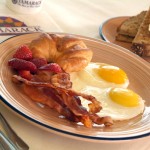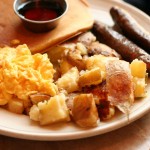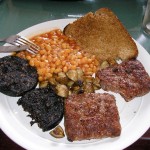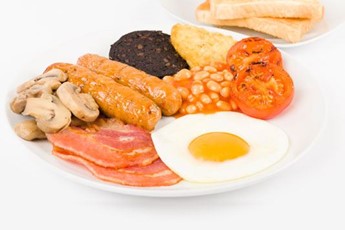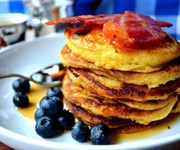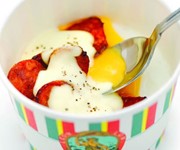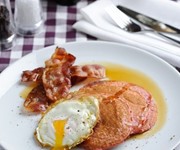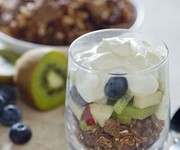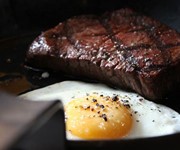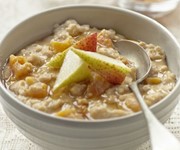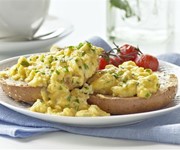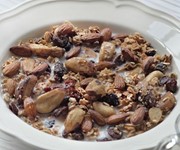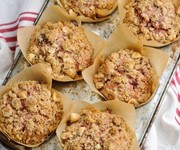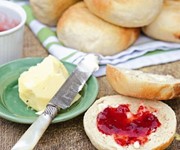Not just English, of course, but certainly there is a tradition of a fried breakfast in many parts of the world, with local variations, so a “full breakfast” is possibly the better description. Certainly many know the “full English” as being the best meal of the day on these isles, the argument being that while the French and other countries make do with the so-called “continental breakfast”, but then serve up inventive cuisine based on wonderful fresh ingredients for other meals, we Brits make do with stodgy muck and Tesco convenience dinners in front of the TV.
At various times this may have been at least partially true, though whether the average French consumer is spending more time sourcing, preparing and cooking proper food than his/her British counterpart these days is debatable – but I hope that both appreciate good food more than in some times past. Breakfasts however have often been sacrificed at the altar of work and studies – our lives get busier, and something has to suffer: a leisurely breakfast was the first casualty.
Porridge may be making a comeback, aided by the good press pinhead oats have been getting from nutritionists, but all too frequently a bowl of cereal, a slice of toast or even less have been the order of the day. Interesting to note that the impact of not having a good breakfast on the effectiveness of pupils in schools has been noticed by schools, who are now offering breakfasts.
By comparison, the English breakfast is from an era when you started with a good meal to set you up for the day. It’s not had a great press in recent years, other than for manual labourers and others who expend a much higher volume of kcals. The full breakfast is unquestionably calorific, high in fat and salt… but it is utterly delicious, can be cooked in a slightly healthier way by judicious use of the naughty ingredients, and does have many variations. For example, my daughter spent the summer months, while home grown tomatoes were ripening on the vines on my patio, enjoying Aga-roasted toms on toast. Very simple and barely fattening, but also delicious.
Some like smoked salmon and scrambles, kippers or kedgeree or a host of other items, but it’s never the same without the “full monty”, which may include any or all of the following:
- Bacon, ideally proper oak smoked dry cure bacon – from a butcher who cures his own if at all possible. My preference is for streaky rather than the leaner back bacon, since the fat keeps the bacon moist, contains all the flavour, and helps it go crisp in the cooking.
- Sausages – not the horrible thin slimy ones with minimal meal, much rusk to absorb the fat, man-made cases, no substance and an unpleasant aftertaste, but proper traditionally-made sausages made from pork with seasonings and just the right amount of fat and just a little rusk or breadcrumb to keep them moist.
- Black pudding – maybe an optional extra, but such blood puddings done well can be very delicious. As a north-westerner I heartily approve of Bury black pudding! Note that Scots may well choose haggis to accompany their breakfast, though that is not common elsewhere in the UK
- Tomatoes – see above for the ideal solution, though some people are happy with canned tomatoes in tomato juice, warmed through. Best option is slow-roast in the oven.
- Mushrooms – delicious sauteed, though if you keep a lid on a heavy-based pan the mushrooms will literally stew rapidly in their own juices. But do avoid having boiling them. You can use a little stock and butter to poach them, but there’s nothing worse than over boiled mushies!
- Eggs – preferably very fresh and direct from source. Leaving aside the scrambled option (see here), tradition dictates fried, though the healthier option is poached. Poaching is quite easy but many people seem to have difficulty with:
- Bring water to simmer in a small pan, add a little salt but vinegar is not required.
- Crack egg into the water (unless you’re using the cling-film method)
- Use a spatula to fold the white over the yolk – gets a nice shape.
- Keep at simmering temperature for about 2-3 mins, then serve directly on hot buttered toast.)
- Toast – always good to have your tomatoes or eggs on toast, possibly for convenient eating, though I do like good quality potato cakes too. Never truly developed a taste for fried slice, though I know many are devotees. Choose a good quality bread, sourdough being perfect. Not too light and not too dark.
- Potatoes – hash browns from the freezer are often the convenience route, though home made are not difficult, and yesterday’s left over boiled spuds make excellent sautee potatoes. Leftover mash and cabbage make wonderful bubble & squeak, a traditional dish that lives on in small cafes up and down the UK.
- Baked beans from the can have an enduring popularity though if you fancy having a go with dried haricot beans they are interesting. Cooking them yourself sometimes ends up with something akin to cassoulet or Boston baked beans, both of which are excellent in their own right!
The American version in particular may end up being served with a stack of pancakes and maple syrup, a habit Adam found odd on our last trip to the USA, when served in conjunction with salty bacon, or even steak & eggs. Other options might include corned beef hash, about which I will write on another occasion. And then grilled kidneys, which are in my humble opinion excellent at breakfast.

PS. Not everyone agrees. This is the alternative view, courtesy of the Guardian:
The Great British fry-up: it’s a national disgrace
The full English breakfast is the most overrated of British dishes – even the name is shuddersome. How did we become shackled to this fried fiasco?
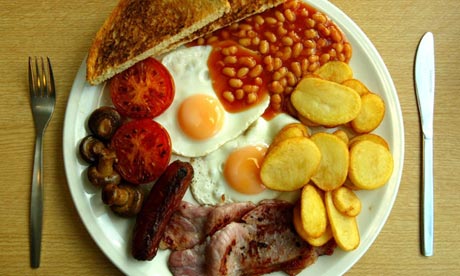 Dog’s dinner: the full English breakfast. Photograph: Chris Radburn/PA
Dog’s dinner: the full English breakfast. Photograph: Chris Radburn/PAIt’s Bacon Connoisseurs’ Week. Not just Bacon Week, in the mould of other PR blarney including Sausage Week or Cupcake Week or Sock Puppet Week, but Bacon Connoisseurs’ Week. You with your watery, smeggy Danish back bacon can naff right off. You, on the other hand, with your hickory-smoked, whisky-cured, Red Tractor-labeled, super bacon, come right in. Have a seat. Eat some bacon.
Everyone is obsessed with bacon. When people start making jam out of something that wasn’t once a fruit you know things have gone a bit loopy. And you can see why we like the stuff – it’s economical, it’s versatile, an imbecile can cook it, and it can be pretty delicious. So why – why, oh why – do we shame it by lumping it, along with so many other fine specimens, in the dog’s dinner that is The Great British fry-up? This is the most overrated of British dishes, the scourge of the breakfasttable, and the cruellest of ends for some of our finest produce. Even the name is shuddersome, unhealthy and redolent of all those Joliveresque expressions that revel in redundant prepositions – cook up, simmer down, brown off, fry up.
The main problem is about quantity. It isn’t, in this case, anything to do with quality. In fact, the better the ingredients, the greater the shame. Because chucking sausage, bacon, black pudding, egg, tomato, beans and so on, all cooked the same way, all on one plate, is always going to end in a train wreck, however good each component is. “It’s the sheer laziness of it,” says food blogger Chris Pople, “the throwing together of different types of protein without any thought of balance or context. Sausages, eggs, bacon, black pudding, each of these things is beautiful in its own right. A fry-up forces them into greasy competition, salty fat against salty fat.”
Bacon-maker par excellence Tim Hayward dissents. “I love a fry up with all my congested heart,” he says. “The full-fried is probably the UK’s greatest gift to the civilised world – the erotic dance of sausage, bacon and egg, the grace note of black pudding, the righteous fried bread …” he trails off, dribbling.
“I find your views shocking and upsetting,” says Seb Emina, author of the Breakfast Bible. “Fry-ups are a way of showing off good ingredients. You take bacon, egg, black pudding, mushrooms etc, cook them to your liking, and arrange them on a plate. That’s it.” But that’s not a dish. It’s a few ingredients, cooked identically, then forced to compete for your attention. Perhaps “British breakfast mezze” might make a better epithet. “It’s interactive, customisable,” argues Emina. I think this mezze thing might work.
I believe we are merely wedded to the idea of the full English, to its place as a homespun, modest, workmanlike, unadorned symbol of Britishness, to its role as a hangover cure (it’s not) and a totem of British cuisine (it isn’t). In no other context would we settle for such a slapdash dish – steak with burger with bresaola, baked potato with chips and mash – and yet through a combination of history and pride we’ve become shackled to this fried fiasco.
Somerset Maugham said that to eat well in Britain you should eat breakfast thrice daily, and perhaps he was right. We’re damn good at it – bacon and eggs, the sausage sandwich, boiled egg and soldiers, kedgeree, bloody marys, eggs benedict, marmalade and toast, gegs, Marmite, all make me leave the breakfast table with a great spring in my step. But we should find the man who decided that the majority of these beautiful things were best enjoyed all on one plate and slap his pudgy wrist. He has done our cuisine a great disservice.
PS. Another view of what should be in an English breakfast here:
Breakfast expert Seb Emina takes us through the ‘magic nine’ items that he says form the classic Full English.
What do a five-star hotel, a high street restaurant and a roadside cafe have in common? It’s definitely not the lunch specials, the customers or the furniture. No, the one thing that is the same, no matter whereabouts in the country you are, is breakfast.
A morning menu will always, always feature a dish claiming to be a ‘full’ breakfast. It will feature eggs, bacon, toast, mushrooms and so on. Popularised by the Victorians, this style of breakfast is our most important contribution to world cuisine. Why else would we call it the ‘full us’?
But how can we be sure that we are getting a full English rather than a mere fry-up? Is there an accepted list of what a full English should contain? In my book The Breakfast Bible I propose that a truly full English should consist of the following ‘magic nine’ ingredients. Anything else is a mere fry-up.
Eggs
Eggs have been a breakfast favourite since the Romans introduced domesticated chickens over two thousand years ago. How you have your eggs says a lot about you. Fried are for the straight-talking, poached are for the ‘healthy’ and scrambled are for the thoughtful.
In the US you get to say things like ‘sunny side up’ and ‘over easy’ but that amount of choice has never really caught on in Britain. An egg cooked too much or too little will ruin a breakfast, no matter what the other ingredients are doing.
Bacon
Britain’s all-time favourite meat, so much so that in the middle ages bacon was used as a form of currency. The phrase ‘bringing home the bacon’ comes from the once-popular sport of pig wrestling, in which the prize for capturing a greased pig was the pig itself.
Today, much of the bacon sold in the UK is Danish but there is someexcellent British bacon to be found. It is worth seeking out.
Sausages
Often this is the ingredient that frightens greasy spoon-goers the most. What is in those mystery tubes? Better a plain cafe sausage, though, than one flavoured with apple or – show me the nearest exit/window – chilli.
Meat percentage is not a simple matter of higher equals better, as breadcrumbs are needed to keep the bangers moist. Still, 80-90% is a good sign. And never prick a sausage. You want that juice.
Mushrooms
Mushrooms were only cultivated commercially in Britain from the mid-twentieth century onwards, making them a relatively new member of the breakfast brigade.
A lot of people have problems with their ‘slug-like’ texture (have these people ever actually eaten a slug?) and will attempt to negotiate additional toast instead. Maybe they were once served tinned mushrooms, still a staple of many a convenience-minded greasy spoon. Americans find the idea of mushrooms at breakfast bizarre.
Tomatoes
When they were first brought back from the American continent, tomatoes were greeted with suspicion. The French thought they were aphrodisiacs and called them ‘love apples’, and the British avoided them for years believing them to be poisonous. Eventually, of course, the fruit caught on. Today it is hard to imagine world cuisine, and especially fried breakfasts, without them.
Too often at breakfast a tomato half is served unloved and under-grilled: hard, tasteless and pointless. In fact it should be tasty enough to do away with the need for ketchup.
Black pudding
One of my favourite Facebook groups is called We all love a full English breakfast. Members post photos of their fry-ups so that others may comment. It can be harsh. Rightly, any pic that does not include at least one slice of black pudding is seen as uncivilised.
I’ve never understood why so many people who happily tuck into economy sausages containing who-knows-what will turn squeamish when faced with this delicious snack, a traditional way of not wasting any of the pig. But their scruples do mean cheap black pudding for the rest of us.
The best are from Bury in Lancashire, Stornoway in the Outer Hebrides or Clonakilty on the south tip of Ireland.
Toast
The act of toasting your bread seems simple, often leading to a false sense of security followed shortly afterwards by disaster. Distracted by the frying of eggs or the turning of sausages, you forget about the toast until, by way of smoke signal (or smoke alarm), it reminds you itself.
Or you forget to take the butter out of the fridge to soften and lose vital breakfasting minutes scraping it onto fraying toast.
Toast, like tea, is one area where greasy spoon cafes often outdo more expensive places, with stacks of delicious buttered triangular slices arriving barely seconds after being ordered.
Baked beans
A controversial ingredient, that many do not accept to be breakfast food. But take a look at the menu of any breakfast-serving cafe and it is hard to argue that baked beans aren’t part of the Full English family.
Native Americans would eat a version stewed in bear fat with maple syrup. This inspired European settlers to create their own take using pork belly and treacle. These Boston baked beans are still a traditional Saturday night meal.
The Heinz version we love in the UK didn’t arrive from the US until the late nineteenth century, and was initially sold as a luxury item from the food hall at Fortnum & Mason in Mayfair.
Potatoes
Also controversial; bubble and squeak is usually acceptable, but the question of hash browns or, dare I say it, chips has ended friendships and caused happy couples to realise they in fact know nothing about each other.
The enlightened among us know that potatoes are very useful for soaking up egg yolk, bean juice and so on. If introducing breakfast potatoes to a non-believer, consider starting off with a halfway house such as Scottish tattie scones or their delicious Irish equivalent, boxty (potato bread)
Regional variations elsewhere in the UK
Of course these items are for a Full English. In recent years we’ve seen the rise of the Full Scottish, including things like lorne sausage, haggis and white pudding (some even talk of adding porridge as a ‘starter’). Meanwhile the Full Welsh adds laverbread and cockles, and the Ulster fry piles on the bread variants with farl, and the aforementioned boxty.
PPS. And a few more breakfast ideas here:
‘Breakfast like a king, lunch like a prince, and dine like a pauper…’ you said it! Here are our hearty, delicious breakfast recipes, all in one place for you to choose from.
RECIPES
American buttermilk and blueberry pancakes with crispy bacon recipe
A sumptuous breakfast or brunch recipe, made extra special with the addition of bacon rashers.
by Leyla Kazim | 30 May 2013
RECIPES
Posh poached eggs in a cup recipe
On our breakfast menu at Leon, we have what we call Egg Cups. We poach eggs in a small pot and add a few things.
by Henry Dimbleby | 01 May 2013
RECIPES
Beetroot pancakes with eggs, bacon and maple syrup recipe
A savoury way to serve pancakes, with beetroot batter, crisp rashers of smoky streaked bacon, fried eggs and a drizzle of maple syrup to finish.
by Genevieve Taylor | 28 January 2013
RECIPES
Breakfast granola recipe
A DIY granola recipe, packed full of healthy bits ‘n pieces including sesame seeds, bran, walnuts and Medjool dates. Serve with Greek yoghurt and fresh fruit.
by Merrilees Parker | 17 January 2013
RECIPES
Breakfast beefsteak and eggs recipe
This is one of the most popular dishes at The Factory House restaurant. Steak and eggs… what better way to start the day?
by Sean Davies | 17 January 2013
RECIPES
Fruity porridge recipe
My husband is a mad keen runner and this is one of his favourite breakfasts before running a marathon. Yup, this ever-so-pretty bowl of fruity porridge fuels him to run for 26.2 miles!
by Nadia Sawalha | 01 January 2013
RECIPES
Herby scrambled eggs recipe
This makes for a lovely (dairy-free) Sunday breakfast and is far healthier than a fry up! I sometimes serve these gorgeous herby eggs with some lean grilled bacon or smoked salmon on the side.
by Nadia Sawalha | 11 December 2012
RECIPES
Cinnamon granola recipe
This granola has so many plus points! It’s easy to make, healthy and it’s utterly delicious too.
by Nadia Sawalha | 10 December 2012
RECIPES
Grapefruit and pecan muffins recipe
Ever put grapefruit in a muffin? It works! Lisa Faulkner adds pecans and fresh orange juice to her batter, too.
by Lisa Faulkner | 28 November 2012
RECIPES
Fluffy eggs recipe
This is a fantastic Sunday breakfast recipe from Kay’s friend Jonny Jeffery. It’s one of those classic family recipes – something his grandmother used to cook for the kids as a treat.
by Kay Plunkett-Hogge & John Vincent | 02 November 2012
RECIPES
Spiced beetroot and apple muffins recipe
Delicious, moist, fragrant muffins… and healthy, too! Remember to add your crunchy hazelnut topping before baking.
by Genevieve Taylor | 19 October 2012
RECIPES
English muffins recipe
The milk in English muffins makes them wonderfully soft in the middle, perfect for splitting and wolfing down with butter and jam.
by David and Holly Jones | 30 August 2012

